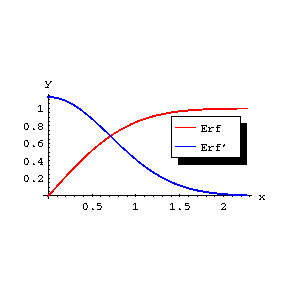Probability integral
error integral
The function
 |
In probability theory one mostly encounters not the probability integral, but the normal distribution function
 |
which is the so-called Gaussian probability integral. For a random variable  having the normal distribution with mathematical expectation 0 and variance
having the normal distribution with mathematical expectation 0 and variance  , the probability that
, the probability that  is equal to
is equal to  . For real
. For real  , the probability integral takes real values; in particular,
, the probability integral takes real values; in particular,
 |

Figure: p074920a
The graph of the probability integral and its derivatives are illustrated in the figure. Regarded as a function of the complex variable  , the probability integral
, the probability integral  is an entire function of
is an entire function of  .
.
The asymptotic representation for large  ,
,  , is given by:
, is given by:
 |
In a neighbourhood of  the probability integral can be represented by the series
the probability integral can be represented by the series
 |
The probability integral is related to the Fresnel integrals  and
and  by the formulas
by the formulas
 |
 |
The derivative of the probability integral is given by:
 |
The following notations are sometimes used:
 |
 |
 |
 |
 |
References
| [1] | H. Bateman (ed.) A. Erdélyi (ed.) et al. (ed.) , Higher transcendental functions , 2. Bessel functions, parabolic cylinder functions, orthogonal polynomials , McGraw-Hill (1953) |
| [2] | E. Jahnke, F. Emde, "Tables of functions with formulae and curves" , Dover, reprint (1945) (Translated from German) |
| [3] | A. Krazer, W. Franz, "Transzendente Funktionen" , Akademie Verlag (1960) |
| [4] | N.N. Lebedev, "Special functions and their applications" , Prentice-Hall (1965) (Translated from Russian) |
Comments
The series representation of the probability integral around  takes the form of a confluent hypergeometric function:
takes the form of a confluent hypergeometric function:
 |
Probability integral. Encyclopedia of Mathematics. URL: http://encyclopediaofmath.org/index.php?title=Probability_integral&oldid=48299